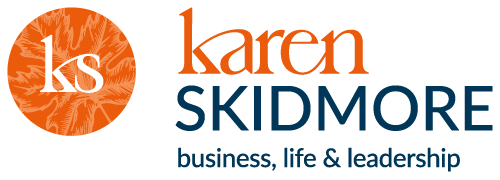
by Karen Skidmore | 03,21 | Business Planning, True Profit
Your business instinct is far stronger than you give it credit for.
However, if you are worn out and feeling frazzled (and hey, don’t we find ourselves at the end of our tethers most days right now!) it’s easy to find yourself fire-fighting your way through your business week.
I want to give you an opportunity to recalibrate and define clearly what it is you need from your business to enable you to grow. In my book, True Profit Business, I teach a model for growth that at its core has something I call The True Profit Compass.
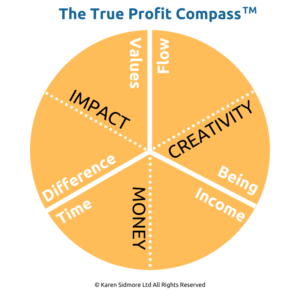 A compass is an instrument used for navigation, but it doesn’t tell you which direction to go in. It aligns you to your magnetic north so you can orientate yourself before deciding where to do next.
A compass is an instrument used for navigation, but it doesn’t tell you which direction to go in. It aligns you to your magnetic north so you can orientate yourself before deciding where to do next.
The True Profit Compass works exactly like this. It aligns you to your magnetic north – your business instinct – and helps you make decisions to design and run your business to serve you, rather than burn you out.
There are three energies at play in this compass; money, impact and creativity. And it’s money that I want to focus on with you today. Although money may not be your core driving motivator for growing your business, there’s no doubt you have a need for money coming in.
I look at money being split into two sections: the time and income needed to help you flourish.
Your time is a limited resource, which often goes unchecked and undervalued. It’s important you consider what boundaries you want to set, and the systems and business model needed to give you the time that you want.
For income you may not need much income for day-to-day living. However, I don’t know many people who started their own business to just ‘get by’ so let’s get you clear on what you need, as well as the amount you want to fulfil your wealth goals and life plan. Plus if you plan to grow, you will absolutely need money for investment in your business growth and expansion (hiring people, putting in systems & marketing budget) so you have to consider how big a business you really want to have one day.
Let’s dive into each one and give you a framework in order to work out what time and income is best for you.
Your time
What hours are you prepared to work?
Very few clients that I’ve worked with over the years have stopped to think how their ideal week or month could look; they have often allowed their business week to be shaped by what their business gives them. If you could reset your work schedule for six months from now, how would it look; how would you spend your time, what hours would you work and which days would you take off?
What is your capacity and availability for taking on new clients or selling new programmes?
I often hear business owners asking for more clients, but they haven’t stopped to consider how many clients would give them a ‘full’ business. Think of your business like a hotel booking sheet. A hotel will have a finite number of rooms to sell for every day of the week. No matter what you sell, you will find there will be an optimum level of clients or products or programmes you can sell, whilst still maintaining the level of service you want to give.
If you choose to maximise your sales and compete on price, you are going to find this a tough marketing strategy; competition is going to be tight and you have to ensure you have the distribution channels or delivery systems in place to keep up with the demand. For most of you reading this, you will have better success in thinking in terms of optimising your sales and deciding how many clients or customers you can serve in any one week, month or programme.
By doing your sales numbers this way, you can work your charge rates and prices back from here once you’ve decided how much you want to earn.
What are you not prepared to sacrifice?
- Are your Fridays sacred?
- Do you have to pick up children every day at 3.30pm?
- Are you happy to work during the weekends but you want two days off during the week?
- Do you always want to have July and August off?
Decide what time you aren’t prepared to give away so you can set those boundaries in place now and avoid frustration or resentment at a later date.
What changes do you want to make in the future to the way you spend your time now?
For some of you, making changes to your current schedule may not be feasible. If you are booked up with work for the next few months, run a busy clinic or see clients in a regular time slot every week or month, then you may need to look at your diary for three or four months hence.
If you want to move your diary schedule around in the future, what will it look like and when do you want to do it? And I’d recommend blocking out this time now before you find yourself filling it with more client work!
Your income
I avoid asking my clients to decide how much money you think your business can or should make. When setting money goals, it’s often your ego that makes these decisions because of external influences; it’s important to be inspired but if all you see, read or hear is success defined by six or seven figures, then this will have an influence on when you believe your business will be successful. What I want you to do here is take a more inward approach to how much income you need and want to make from your business.
Let me share a story about a client I recently worked; she came to me with a financial target of £100,000. But once we worked out how much she needed to live on, how much she wanted to invest in her business and how many clients she actually wanted to work with at any one point, it turned out she didn’t need to stretch herself to find £100,000 in sales over the next year; her actual financial target was only £65,000.
This was her third year in business and, although she had achieved great things, she was exhausted by selling too many low-priced programmes and dealing with a 6,000 strong Facebook community. Once we had worked out her income streams, simplified her products and programmes to give her less to sell, and mapped out her marketing campaigns for the year ahead, she was visibly more relaxed; she had far less to do than she thought she’d end up with.
It turned out that the initial financial target of £100,000 came from the pressure she had been putting on herself to be seen as successful by her peer group, and if I’d been focused on helping her achieve her original six-figure target, she would have ended up burnt out and putting in the wrong growth strategy.
She still wanted to grow a six-figure business at some point, but her growth strategy for the next year was about simplifying and restructuring her business model so she had a stronger and more sustainable foundation from which to build on in the following two years.
This is why it’s important to know your financial needs right now, as well as what you want to achieve, and keep reviewing them as you grow. Don’t chase figures based on what you think is expected of you or your business.
How much income do you need right now?
If you haven’t done so already, you need to work this out. Not in your head; sit down with your bank statements, your bills and a calculator. If you are living with someone else, this may be a joint conversation. If you need to get a grip on your credit card debt or long-term savings plans, get help and speak to a financial advisor.
Too many business owners don’t know what they need to earn and are simply going about their sales on a wing and a prayer.
How much income do you want in the future?
Is there a savings pot you want to fill up? Have you got short- term savings you want to build for a holiday? Or perhaps longer-term savings for investing in a second property or pension? Again, get help from a financial advisor if you need to. Don’t wishfully think what you want; work out what that figure needs to be and over what time period you could work towards it.
What does your business need to sell to give you these income figures?
Once you’ve worked out your income figures, how does this translate into turnover figures? Remember, your income is different from profit (you have to pay tax), which is different from turnover (you have expenses). So once again, if you haven’t got these figures clear yet, work them out.
This money work is a big part of what we do in Momentum, our business growth programme. Yes, sales targets are set but without doing the work on what net/gross profit, business costs and forecasted income, you could be building a business on shifting sands; whatever growth in sales you get one quarter, disappear in the next because you haven’t got a solid money foundation in place.
What short-term ‘costs’ will give you long-term ‘gains’?
You may be in a period of growth in your business where your expenses are high because you are investing in new systems, processes or hiring team members. A lack of cashflow is what causes most businesses to fail, so rather than waiting to sell ‘enough’, do you need to seek external financing to fund your growth plan? If so, what options can you look at or how much do you need?
What now?
Working through this framework will help give you your magnetic north. You’ll find more about how to work through the energies of creativity and impact in my book, True Profit Business. But in terms of money, I hope that you can see how this can help stop you chasing pie-in-the-sky figures that are often fed to us by what we see on our social feeds, and now have realistic and sustainable figures to work towards, whilst still giving you opportunities to stretch.
Money pressures can break us.
And when we don’t give ourselves this opportunity of spending time to fuel our business instinct and working on our navigations from our True Profit Compass, we end up exhausting ourselves. Burn out is not a rite of passage to success … you can design your business to work FOR you and what it is you want out of life.
Until next time, do less, be more and play bigger.

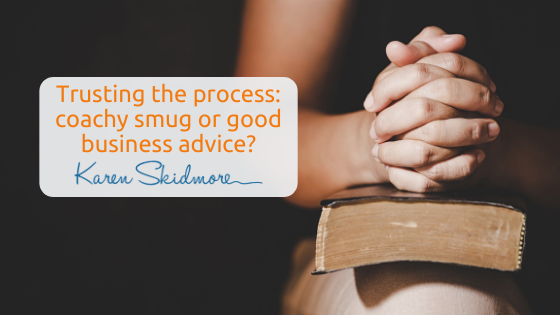
by Karen Skidmore | 10,20 | Business Planning, True Profit
Has anyone ever said to you ‘trust the process’?
I used to hate this phase; I felt it was such a ‘coachy’ thing to say and it irritated the pants off me when anyone tried to use it with me.
It’s often said in the context of someone working hard, trying to get something to work. And if you’ve been in business for more than just a few months, you’ll know that there are plenty of things that can feel really hard work to get working.
Can’t get your marketing working? Trust the process.
Can’t find the right person to hire? Trust the process.
I didn’t have time to trust the process; I needed to get on and get stuff done. If something wasn’t working, I believed I just had to work harder at it.
Fast forward to today and ‘trust the process’ is a phase that me and my team use a lot with our clients. But not in the ‘coachy’ smug way that I remembered it as when I first got going back in 2004.
To be clear: trust the process can only work if you have a process in place to trust. It’s not about lighting your incense burners, closing your eyes and praying to the business gods to deliver. There is a process and system for anything and everything that you do in your business. From marketing to launching and from hiring new team members to letting go of the ones that don’t work out.
Let’s take my event, Embrace, as an example. Some may call me crazy to be putting together a three day event in just three weeks, but there are several reasons why it’s flowing together so easily.
1) Strategic Thinking: this isn’t a knee-jerk reaction to an urge I had.
Embrace has been brewing for some while now and there is a bigger vision that’s helping me steer this event.
2) Team: this isn’t something you try to do by yourself.
I already have a strong team; Alexia who started as my VA 12 years ago and now takes on the role of Operations Manager and Events Manager, and Melina who came on board as a Senior Coach for my Momentum clients. Plus I reached out to my good buddy, Nicki Williams, to co-host this particular event with me; I’ve realised it’s more fun to do projects like this with people you like 🙂
3) Asking for help: you don’t need to figure this out yourself.
One thing that was really important to me for this event was to have a diverse speaker line up. The recent #blacklivesmatter campaign this year opened my eyes to how much of a white privilege bubble I lived and worked in. So making sure I didn’t just rely on my business buddies and clients to fill the speaker slots, I asked in various communities for help in connecting me with women from different cultures and communities. We haven’t got it perfect and I know there’s more work I can do with more time available, but I am bloody proud of what we’ve created.
4) Process: everything runs more smoothly with a process.
Although this is the first three day event I’ve run, I’ve been running webinars and one day training events for most of my business life. Back in 2005 I launched a women’s networking group which grew to four venues across Surrey & Berkshire. I know that an event is easier to run because of the processes.
We have a process for speaker enrolment, for creating the event page, for registrations and using the zoom platform, for delegate packs and more. Everything that we do in my business more than once, quickly becomes a process. It gets documented either in a google doc or it gets Trelloed (we use Trello.com to manage our events, programmes and marketing campaigns).
And that’s why I now love the phrase ‘trust the process’.
With the right processes in place, it means you can trust through the good days as well as the bad. Because some things won’t go according to plan. Some expectations won’t be met. But with processes in place, it means I can release the worry and stress that I used to have many years ago.
It means I don’t have to get hung up on the exact, specific outcomes. I know where I am headed and the processes don’t restrict us but allow myself and my team open to possibilities and opportunities we hadn’t seen or thought of.
So how has this inspired you to take a look at your processes in your business?
I’d love to know.
There’s a really great chapter in my book True Profit Business that takes a look at the core processes that are fundamental to your business growth. If you are interested, let me know and I can write about it next week.
In the meantime, if you want to know more about our event Embrace Midlife & Menopause, here’s the link: www.karenskidmore.com/embrace
It’s a three day festival of inspiring conversations, expert interviews, panel discussions and women circles, which the amazing Nicki Williams, hormones specialist, is co-hosting with me. We are welcoming everyone and anyone -men & women, of any age – who wants to join the conversation. And if this isn’t for you, then can I ask you to think who do you know who needs to access this event?
Until next time, do less, be more and play bigger.


by Karen Skidmore | 08,20 | Pillar Articles, Stories, inspirations & thoughts for the day, True Profit
The heat has been vicious here over the past few days. Having been a teenage sun worshipper, I have now become a version of Patsy; floating around the house in my beach kaftan, sighing, “I like it hot, but not this hot.”
To make matters a little hotter, we are having an extension built.
The back out of our house is boarded up, blocking any form of breeze able to drift through. And with both front and back gardens full of cement boards, diggers and skips, there is no chance of finding a shady corner outside, either.
So this weekend, I found myself dragging a chair into our hallway to sit in front of the open front door, and gave myself permission to do nothing but read for two days.
The book I found myself immersed in for the whole weekend was Wintering; a story of how the author, Katherine May, learned to flourish when, as she calls it, life becomes frozen.
And yes, the irony of reading Wintering in the middle of a heatwave was not lost in me.
As it turned out, it was the perfect book to read.
A client recommended it to me after we spent time together working through how she could build a business, without having to jeopardise her health. Our discussion took a deep dive into how important rest was. Together, we worked out how to develop a work rhythm that would allow her to sell enough to meet her money goals while avoiding the need to fight hard to keep up with it.
It seems to be me that rest is something that very few people feel good about taking.
Over the past decade, our society has sped up to allow us to buy anything, chat to anyone, post online anywhere, 24 hours a day. Our patience to wait for things is no longer needed, which has no doubt impacted on the fact that patience with ourselves has been pushed aside, too.
I live in a country that not only has vast changes to our daylight hours throughout the year, from 16 hours in the summer to less than 8 hours in the winter but is also buffetted from our island’s ever-changing weather patterns.
In a matter of days, we can go from clicking on our central heating system in the middle of June to wondering how much it would cost to run air conditioning for the few nights of the year that seem to cook us from the inside out. (Nothing like a slow roast when you are going through the menopause!)
And yet it seems that us Brits do our best to homogenise our work patterns so that we can still go at it hard no matter how many hours of daylight we get in a day; no matter what the season is; no matter how tired we feel or what in life we are dealing with.
We are conditioned to keep working at a pace because going slow would be wrong, yes?
I fought rest for a long time.
I had images of laying on the sofa, watching TV and eating wotsits. What a waste of my time! I couldn’t possibly allow myself to do nothing. That would be so unproductive.
Rest was for sick people; people who were signed off by their doctor and needed to recover from a severe illness. Rest wasn’t for someone like me, who had things to achieve and goals to reach.
But over the years of learning how to slow down and let go of my over-achiever self, I have realised how powerful rest is. So when I got my hands on my Katherine May’s book, Wintering, I couldn’t put it down. I read it from cover to cover.
Not only does she tell her own story of recovery, but she also interlaces it with interviews and research of the power of winter; that point in your year where you shift down a few gears, rest and sleep more.
She writes “Transformation is the business of winter… a cyclical metaphor for life, one in which the energies of spring can arrive again and again and again, nurtured by the deep retreat of winter. We are no longer accustomed to thinking in this way. We are instead in the habit of imagining our lives to be linear; a long march from birth to death in which we mass our powers, only to surrender them again, all while slowly losing our youthful beauty. This is a brutal untruth. Life meanders like a path through the woods. We have seasons when the leaves fall from us, revealing our bare bones. Given time, they grow again.”
Let’s face it. You’ve had your from-hell-and-back moments, haven’t you?
The older and wiser we get, the more travelled our paths become. Whether you’ve lost a parent or a child; recovered from illness or an accident; dealt with bully bosses or redundancy; closed down a business or declared bankruptcy; had a divorce or broken heart; everyone has one, if not several, periods of life where you are put under extreme stress.
And as you grow older and you experience changes in your hormones and body, stress is often harder to deal with. Without real rest and recovery time, it layers upon previous stressful times until you find that you can no longer cope.
And yes, your body has a way of making you stop if it needs you to!
How many of us have allowed us to truly winter?
To believe that resting and taking time out will allow your creativity and impact to form? Because, after all, Wintering doesn’t just happen in the winter season. Resting can happen at any time you need it. And often resting needs to occur BEFORE you think you need it.
In Katherine’s concluding chapter, she writes “To get better at wintering, we need to address our very notion of time. We tend to imagine that our lives are linear, but they are in fact, cyclical. I would not, of course, seek to deny that we grow gradually older, but while doing so, we pass through phases of good health and ill, or optimism and deep doubt, or freedom and constraint.”
This is my hope for us all at this crucial point of 2020.
As I write this, it is the middle of August, traditionally the month of holidays before we gear back up for the back-to-school busy-ness of September. Whether you have school-age children or not, we were all school-age children once upon a time so this energy of a new academic year is often inbuilt into many of us.
But the danger is that we, as a society, haven’t really and truly rested. Yes, we’ve had enforced lockdown and haven’t been allowed to go anywhere for weeks and weeks. But very few people seem to have really and truly found the time and space to process what has happened over the past few months.
And let’s be clear, we have all been through catalytic changes to the way that we live and work. The levels of anxiety bubbling through our communities are running high, with many on alert, waiting for the latest breaking news to ping through on their phones. Not one person has been unaffected by what has happened this year.
It feels to me that the more we can allow ourselves time for a good wintering, the more chance we have to flourish and become our potential, rather than chase a version of ourselves born out of busy-ness.
Rest is not just for people who need to recover from an illness. Rest is a critical stage of our cycle of growth, both for ourselves as people and for our businesses.
Rest doesn’t have to be sitting on a sofa, binge-watching the latest box set (although it could be). It doesn’t have to be sleeping all day (although it could be). Rest doesn’t have to be isolated time to yourself (although it often is).
Rest can be your version of how you shift down your gears and take the time and space to breathe; to review and reflect; to ignore your phone and forget about what time it is.
Rest can be for an hour, for a day, even a whole month or longer.
Rest can be the opportunity to feel into your power; to ground your energy; to connect with who you are, where you can impact and what is it you desire.
Whatever version your rest becomes, one thing I know for sure is that rest has got to happen BEFORE you think you need it.
Who’s up for a bit of wintering in a heatwave?
Until next time, do less, be more and play bigger.

Books Referenced:
Wintering by Katherine May
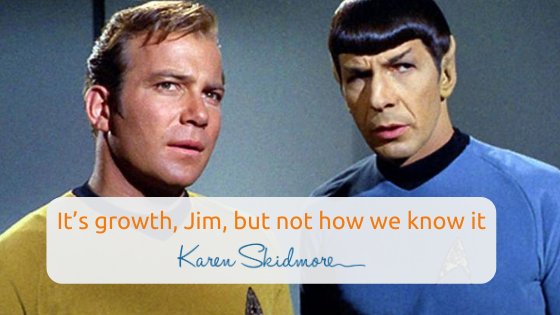
by Karen Skidmore | 08,20 | Business Planning, Pillar Articles, True Profit
One thing you may not know about me is that I am an economics nerd.
I took Economics A Level at school, which was the nearest thing I could study to business due to the limited range of topics on offer.
Even back in 1987, the growth models taught just seemed to be outdated. If countries were going to continue to use GDP (Gross Domestic Product) as a measure of growth, at what point would the charts stop working? You couldn’t just keep going up and up each year, could you?
And this frustrated and bored me, hence my disappointing D grade!
When Freakonomics came out in 2007, I couldn’t put it down. It re-ignited my love for the subject and I came back to exploring and questioning what economic growth meant. But I still couldn’t get my head around the way our economic growth was measured.
Then in 2018, a brand new economics book came out; Doughnut Economic; Seven Ways to Think Like a 21st-Century Economist.
Have you read it?
I’m guessing that unless you are an economic nerd like me, probably not. It’s a great book, but it’s not exactly one of the must-reads of marketing or business books. But for me, OMG … I couldn’t put it down. This was what I had hoped my A-Level course could have focused on when I was 17.
Kate Raworth changed the goal from GDP to Doughnut; identifying how mainstream economics has led us astray by obsessing over growth at all costs, to offering a new model that “brings humanity into a sweet spot that meets the needs of all within the means of the planet’.
OK, great. That all sounds amazing, yes … but what the heck has it got to do with the likes of you and me?
Well, everything IMO.
This backdrop of macro-economics has contributed to our current business culture; work hard to get more.
Do more to get more.
But the good news is that I’ve started to feel the shift.
And I hope you have, too.
These past few months have been a catalyst for so much change … yes, with all changes there is often much discomfort (and sometimes a lot of pain). But the changes feel hopeful; especially in our business culture.
I am witnessing growth in more ways than just money in the bank and numbers of clients in a Facebook Group. Yes, more money is still necessary to many of us. But I’m seeing growth being measured in time spent with family and friends; in our health and fitness; in the impact and difference we can make to people’s lives.
These growth measures are no longer only seen fit for our social enterprises, charities and not-for-profits. They are growth measures fit for our commercial businesses, and the likes of you and me.
And this is what I call True Profit.
True Profit places you, your impact and your wellbeing at the heart of your business, while still recognising the importance of profit and cash flow.
I’d love to know how you are planning to measure your growth over the coming year. Rather than counting pounds in your bank or numbers of clients in a Facebook group, what growth is vital to you?
Until next time, do less, be more and play bigger.

Books Referenced:
Freakonomics: https://www.amazon.co.uk/Freakonomics-Economist-Explores-Hidden-Everything/dp/0141019018
Doughnut Economics: https://www.amazon.co.uk/Doughnut-Economics-Seven-21st-Century-Economist/dp/1847941397
True Profit Business: https://www.amazon.co.uk/True-Profit-Business-without-burning/dp/1788600843/
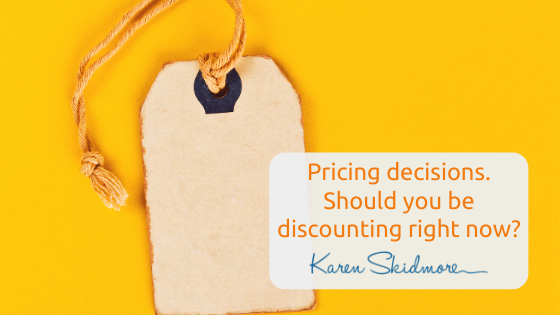
by Karen Skidmore | 03,20 | True Profit
There’s a lot of fear and worry around right now. I get it. There’s no doubt many small businesses are being hit hard right now.
And it’s influencing pricing decisions.
I’m seeing a lot of people making free offers or discounting their products and programmes as a way of trying to generate income. But discounting to survive is a slippery slope, especially when your offer gets drowned out by all the other discounters. Plus you run the danger of creating something that you simply won’t be able to sustain over the coming months. Low prices mean you have to have a high volume of clients to give you the same level of income before you started to discount. You have to be sure you have the resources, mindset, systems and team to support you long past the initial creation and launch.
Flight or fight is there to save you in a life-threatening situation. It’s not to help you decide how to price your products.
If you are feeling rattled, anxious or worried, don’t let yourself knee jerk your way through your business right now. Take a moment to review your current pricing decisions and, if you are wondering whether you should be discounting, follow these steps first.
Step One – Get clear on the value you offer.
Read through your testimonials and case studies and remind yourself exactly what it is you do for others. I teach my clients to follow the guidelines of Partnership Power; both they and their clients are equal in the relationship of buying and selling. If you feel you want to start discounting and this is coming from a place of fear, then you are giving up some of your selling power.
You can very quickly go from being of service to being a servant, which you’ll find challenging to shift back from.
Step Two – Decide what you want out of making a new offer.
Do you really need to worry about income right now? Yes, there is every chance you have to assess your position in the market place and what you can be adjusting and adapting to in the next few weeks and months. But be aware of how quickly one can get whipped up into a worry storm when everyone around you is too. If you get caught up with the busy-ness of creating new, cheap or free offers, then you’re going to find it difficult to assess the bigger picture and see the True Profit™ opportunities ahead of you.
If it’s a genuine offer of help you want to make to your clients – a short term offer that you’re making to be of service in a time of need – then create a product to reflect the price. Thus you aren’t discounting but creating a new, low priced product.
Step Three – What do the top 20% of your marketplace want help with right now?
The Pareto principle states that 80% of results come from 20% of the effort, so see how this is working in your marketplace right now. Many of your clients will be experiencing fear and worry too, so the truth is that you may not be able to help most of them right at this moment in time.
Lots of people are setting up new free Facebook groups, often coming from a place of genuine desire to help and support. However, there is a danger that they will be getting distracted by a multitude of conflicting messages.
Your job right now is to find the top 20% of your marketplace and engage with them.
“The person who chases two rabbits catches neither.”
Step Four – Create an offer that serves your clients right now … as well as in the near future.
If you feel you want to make a lower than a normally priced offer, then create a programme or service that reflects that price. It may be that what your clients want is a quick-fix, short term solution to help them through the next few weeks. It may be that they need help to play the long game and they need a virtual or digital programme to support them, little and often.
Come back to the purpose of making your offer and whether you need to make sales right now, or whether you need to take time out to review, assess and plan for your future.
If you are like many of the clients that I work with, you run a low-cost business that sells your expertise, talents or skills in some form or other. You may have a small team, and although you probably aren’t one of the many thousands of businesses who will be able to take advantage of the Government’s funding and assistance in the coming months, you will be agile enough to not only adapt but to grow in the future.
A previous business mentor of mine taught me that money loves speed. However, I’ve come to believe, now more than ever, that the power is in the pause.
Create the space to let our current situation settle.
Take the time to feel into your next move.
Until next time, do less, be more, play bigger.

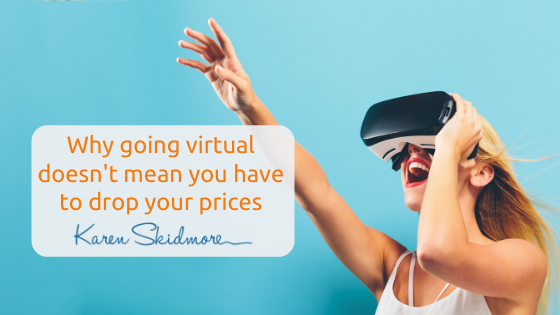
by Karen Skidmore | 03,20 | Marketing Articles, True Profit
We are about to go through one of the most intensely disruptive phases of how we do business. As I write this, countries across the globe have shut their borders and here in the UK, we are realistic about what’s going to happen over the coming days.
With the prospect of no longer being able to travel, many of my clients who deliver in-person training, coaching, therapy and support are being faced with cancellations and postponements of work with no real idea on when and how it’s going to happen. I have my own in-person training day coming up soon so I’m not so glib to know we simply shrug our shoulders and wait patiently for the bookings to return. This health crisis we are faced with is going to affect our businesses and some more than others.
However, this is also a huge opportunity to stretch your thinking and evaluate how you may still deliver your programmes and services, despite not being in the room with them.
When I first started up my coaching business back in 2004, it was a mix of phone coaching and face to face. At first, I believed that face to face was more powerful and I would charge less for phone call coaching. My thinking was that because I wasn’t ‘there’ for them, being on the phone somehow diminished my impact and expertise in being able to help them. I was, of course, challenged by my coach at the time (because that’s what a good coach does, yes?!) and I was able to see that the choice of delivery should never be an excuse for reducing prices. And, in fact, virtual can often be seen as a premium option.
When I teach my principles of True Profit™ Business, I actively encourage my clients to create and design a business model that fuels them. So often the need for in-person work comes up high for many spiritual, intuitive and introverted coaches, therapists and trainers. But I also see a lot of people use their fear of using technology as an excuse not to explore virtual work; especially when their industry norms are to be in the same room as their clients. Professionals such as nutritional therapists, counsellors and image consultants often tell me that their clients would expect to come and see them in person, so doing virtual sessions just wouldn’t work. But is that really the case? Or because everyone else does it this way, so you should too?
I get that for some of you who physically treat your clients, that virtual work will be far more challenging, if not impossible. But for many of you, these next few weeks could be a great opportunity to challenge your norm and explore the work that you do with your clients via platforms such as Zoom.
And just because webinars are now seen as something free to offer as a lead generation marketing tool, this does not mean you can’t charge for them. But only if you do the thinking and create the value through the experience, support and your expertise.
Going virtual doesn’t mean you need to drop your prices.
And here’s why.
- Your expertise does not diminish because of a change of platform. Just because you are not in the room with them, you don’t suddenly know less or lose a qualification.
- The experience changes but not the value. If a one day training workshop is reduced to a 90 minute webinar, yes I get that your client may expect a discount because they may be thinking about the time it takes you to deliver. Now it’s less, then they pay less. So it’s up to you to really think about the support before and after the virtual session. What can you offer to make the session more experiential? Printed workbooks sent out in the post before the event or prep work to be done before people show up to the session are two great add-ons that can be adapted from your in-person agenda. So you may charge less than a one day training but not proportionally so.
- Adding value through on-going support. Your clients need help implementing after your session so you have groups available on Facebook and LinkedIn as well as platforms such as Mighty Networks and Slack. For intimate, small groups it could even be a simple WhatsApp group as long as everyone is OK with sharing their mobile phone numbers.
- Recordings and playback. One of the huge benefits of virtual training and support is being able to record and provide your clients with the audio or video file after the event. Keep it simple to begin with. You don’t need to overcomplicate the process by signing up for big digital course platforms; share files on Dropbox or upload onto a private video hosting sites such as Vimeo.
- The convenience of availability. Don’t let the fact that you no longer have to pay for venue or catering costs reduce your pricing. The convenience to your clients means that they no longer have to travel and they have more time back in their day so that is a huge value to them. Never assume your clients are going to see this so it is up to you to highlight this in your proposition.
We are going to be experiencing some dramatic and chaotic times over the coming weeks and months and this is your opportunity to disrupt your current thinking and explore how you may continue to serve your clients, and avoid a high level of cancellations.
Yes, delivering your services and programmes virtually will need you to learn new skills and adapt your style. But for those of you who do this and learn how to deliver powerful virtual training, you are going to be in high demand in the very near future, especially so for those of you who support your clients’ health, mental and spiritual well being.
Now is the time that your clients need you more than ever.
Until next time, do less, be more, play bigger.


 A compass is an instrument used for navigation, but it doesn’t tell you which direction to go in. It aligns you to your magnetic north so you can orientate yourself before deciding where to do next.
A compass is an instrument used for navigation, but it doesn’t tell you which direction to go in. It aligns you to your magnetic north so you can orientate yourself before deciding where to do next.
